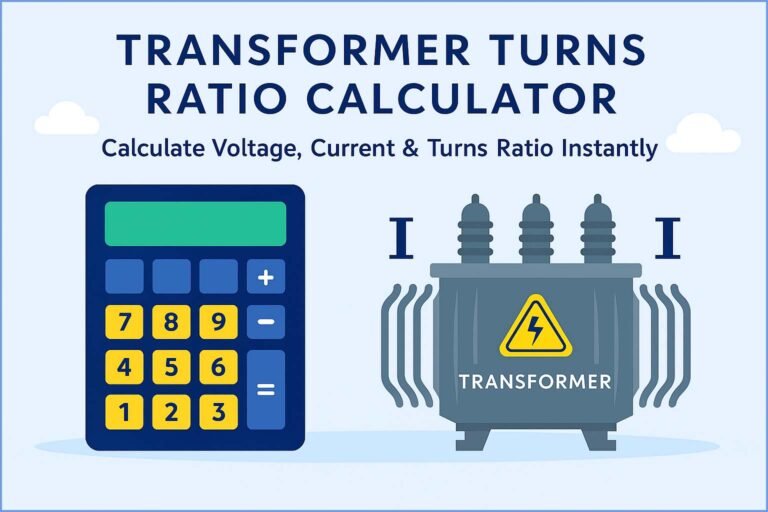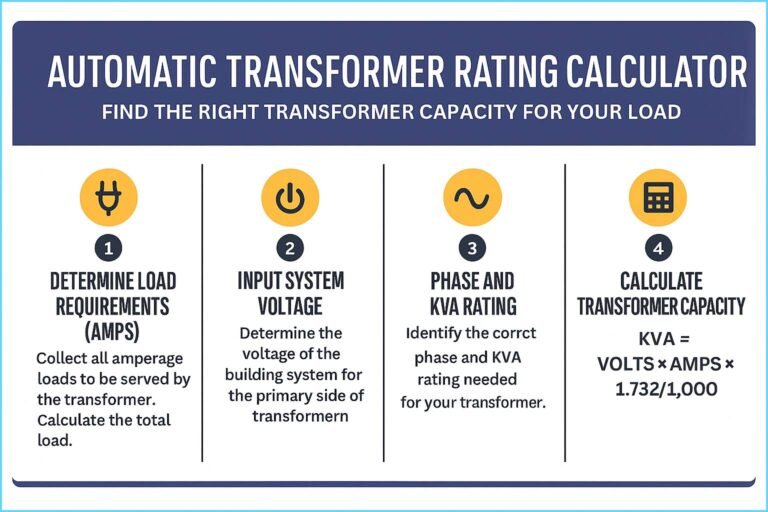Armoured Cable Bending Radius Calculator – Accurate Tool for Safe Cable Installation
Understanding the bending radius of armoured cables is essential for safe and efficient electrical installations. Incorrect bending can lead to internal damage, insulation failure, and long-term reliability issues. An armoured cable bending radius calculator helps engineers, electricians, and contractors determine the correct minimum bend radius for different cable types. This article explains what it is, why it matters, how to use it, and provides practical examples for real-world applications.

Table of Contents
What Is an Armoured Cable Bending Radius Calculator
An armoured cable bending radius calculator is a tool designed to estimate the minimum safe bending radius of armoured cables. The calculator considers cable type, diameter, insulation, and construction to determine how tightly a cable can be bent without damage.
Armoured cables, such as SWA (Steel Wire Armoured) and AWA (Aluminium Wire Armoured), have metal sheaths for mechanical protection. However, this also limits flexibility. When the cable is bent below its recommended radius, it can cause cracks in insulation, break copper strands, or loosen armour layers.
The bending radius calculator eliminates guesswork by giving you accurate bend limits for safe installations.
Armoured Cable Bending Radius Calculator
Armoured Cable Bending Radius Calculator
IEC-style radius rules with manufacturer override, plus bend geometry (arc/chord) for planning sweep bends.
– Enter the cable’s overall diameter from the datasheet. Select cable type and installation condition to apply the correct factor.
– Optionally input a custom factor k if your manufacturer specifies a different value (always defer to datasheet).
– If you have a planned bend radius or a mandrel/roller diameter, enter them for a compliance check.
– Set a bend angle (e.g., 45°, 90°, 120°). Click “Calculate” to see minimum radius/diameter, PASS/FAIL, and bend geometry (arc/chord).
– Use the geometry outputs to plan sweep bends, spacing, and developed length for installation.
Bending limits depend on cable construction, armour, temperature, installation method, and manufacturer specification. When in doubt, use the higher factor and consult the cable datasheet.
Why Bending Radius Matters in Armoured Cables
The bending radius defines the smallest radius a cable can bend without mechanical stress. Every cable has a manufacturer-specified limit depending on its design and voltage rating. Exceeding this radius can lead to electrical faults and early cable failure. Use our online tool 3 phase cable size calculator
When cables are forced into tight corners, their internal conductors may stretch on the outer side and compress on the inner side. Over time, this weakens the insulation and armour layers, increasing the risk of short circuits or conductor breakage.
Using an armoured cable bending radius calculator ensures cables are laid with enough curvature to prevent mechanical strain. It also helps comply with IEC and BS standards during electrical design and inspection.
Factors Affecting Bending Radius
The minimum bending radius of an armoured cable depends on several factors:
- Cable Type: SWA, AWA, or flexible armoured cables have different mechanical stiffness.
- Cable Diameter: Larger cables require a greater bending radius.
- Voltage Rating: High-voltage cables are built with thicker insulation and thus less flexible.
- Installation Condition: Whether bending occurs during installation (cold condition) or while the cable is energized (hot condition).
- Manufacturer Recommendations: Each brand may provide its own radius limits.
These factors are important inputs for an accurate bending radius calculation. Try our free online tool today ev charger cable size calculator
Standard Bending Radius Guidelines
Industry standards like IEC 60502 and BS 6622 define general bending radius limits for various cables. The table below gives a summary of typical values used in calculations.
| Cable Type | Typical Bending Radius | Example Formula |
|---|---|---|
| Single-core armoured cable | 15 × cable diameter (D) | R = 15D |
| Multi-core armoured cable | 12 × cable diameter (D) | R = 12D |
| Flexible armoured cable | 6 × cable diameter (D) | R = 6D |
| XLPE insulated cable | 12 × cable diameter (D) | R = 12D |
| PVC insulated cable | 10 × cable diameter (D) | R = 10D |
For example, a 50 mm diameter SWA cable would have a minimum bending radius of:
R = 12 × 50 = 600 mm.
This means the cable should not be bent with a radius smaller than 600 mm.
How to Use an Armoured Cable Bending Radius Calculator
An online armoured cable bending radius calculator simplifies this process. Here’s how you can use it effectively:
- Enter the cable diameter in millimeters.
- Choose the cable type (single-core, multi-core, flexible).
- Select the insulation type (PVC, XLPE, or EPR).
- The calculator automatically applies the relevant formula.
- The result displays the minimum safe bending radius.
For example, if you input a 25 mm diameter multi-core XLPE cable, the calculator might return:
R = 12 × 25 = 300 mm.
This means the installer should ensure a minimum 300 mm bend radius during installation. Access our powerful online calculator now star delta motor cable size calculator
Example Bending Radius Calculation
Let’s calculate manually using an example:
Given:
Cable type = 4-core SWA, 95 mm²
Overall cable diameter = 42 mm
Formula:
Minimum bending radius = 12 × D
= 12 × 42
= 504 mm
Therefore, during installation, the minimum bending radius for this cable is 504 mm.
To simplify this process in the field, the armoured cable bending radius calculator gives quick and reliable results using these same formulas.
Bending Radius for Different Armoured Cable Sizes
Below is a table showing approximate bending radius values for common armoured cable sizes:
| Cable Size (mm²) | Approx. Diameter (mm) | Bending Radius (12 × D) |
|---|---|---|
| 10 mm² | 15 mm | 180 mm |
| 25 mm² | 20 mm | 240 mm |
| 50 mm² | 27 mm | 324 mm |
| 70 mm² | 33 mm | 396 mm |
| 95 mm² | 42 mm | 504 mm |
| 120 mm² | 45 mm | 540 mm |
| 150 mm² | 50 mm | 600 mm |
| 185 mm² | 55 mm | 660 mm |
| 240 mm² | 60 mm | 720 mm |
These values are indicative and can differ slightly depending on manufacturer design and construction material. Get instant results with our online tool earth cable size calculator
Recommended Installation Practices
To achieve safe bending and maintain long-term reliability:
- Always check manufacturer datasheets before installation.
- Avoid bending cables at very low temperatures; pre-warm them if necessary.
- Use cable rollers or drum jacks to ensure uniform bends.
- Never pull the cable beyond its tensile strength limit.
- Ensure bends are smooth and gradual, not angular.
Following these practices helps maintain the cable’s insulation integrity and prevents performance loss over time.
Benefits of Using an Armoured Cable Bending Radius Calculator
Using an armoured cable bending radius calculator offers several advantages:
- Saves Time: Quickly determines safe bend limits without manual calculations.
- Improves Accuracy: Ensures compliance with international standards.
- Enhances Safety: Reduces risk of cable damage and electrical faults.
- Increases Efficiency: Helps plan routes and bend radii before installation.
- Supports Design Engineers: Useful for preparing layout drawings and project documentation.
In large installations such as substations, industrial plants, and solar farms, using a calculator ensures cables are installed safely and efficiently. Start using our easy-to-use online tool earthing cable size calculator
Bending Radius and IEC Standards
IEC 60228 and IEC 60502 are the key standards governing armoured cable construction and bending radius. They define minimum bend radii based on conductor size and insulation material.
For example:
- For single-core armoured cables: 15 × D minimum
- For multi-core armoured cables: 12 × D minimum
These standards are used globally by electrical engineers and inspection authorities to verify safe cable routing and mechanical protection.
Common Mistakes During Cable Bending
Despite having the right data, improper handling can still lead to problems. Common mistakes include:
- Bending cables sharply near terminations or glands.
- Using the wrong drum or pulley size during installation.
- Ignoring cold weather limitations.
- Applying excessive pulling tension during laying.
Avoiding these errors ensures cables retain their full lifespan and rated performance.
Applications of the Calculator in Real Projects
The armoured cable bending radius calculator is useful across many industries. Some examples include:
- Solar Power Plants: Determining bend radius for large DC armoured cables.
- Data Centers: Ensuring high-density cable trays meet bend radius limits.
- Industrial Automation: Planning flexible routing for heavy-duty power cables.
- Utility Substations: Designing underground and overhead connections safely.
Engineers use it both in design stages and during on-site inspection. Calculate instantly with our smart online tool cable size calculator australia
Frequently Asked Questions
What is the bending radius of a 25 mm SWA cable?
For a 25 mm diameter SWA cable, the bending radius is about 12 × 25 = 300 mm.
Can I bend armoured cables tighter than the recommended radius?
It is not recommended. Tight bending may cause damage to insulation or armour layers, reducing cable life.
Does temperature affect the bending radius?
Yes. At low temperatures, cables become stiff. Always follow the manufacturer’s temperature bending limits.
Are the bending radius values different for flexible armoured cables?
Yes. Flexible armoured cables usually have smaller bending radius values, typically 6 × D.
Do standards specify different bending radii for XLPE and PVC cables?
Yes. XLPE cables usually require larger radii due to thicker insulation.
Conclusion
The armoured cable bending radius calculator is a valuable tool for safe electrical design and installation. It ensures cables are laid with proper curvature, preventing mechanical and electrical damage. By following standard formulas like 12 × D or 15 × D, engineers and electricians can ensure compliance with IEC standards and maintain system reliability. Explore our professional online tool for quick calculations kw to cable size calculator
Whether you’re installing SWA cables in an industrial plant or routing power cables in a solar system, using this calculator ensures every bend is safe, accurate, and efficient. Understanding and applying the correct bending radius is not just a technical requirement—it’s an essential step for safety, performance, and long-term durability of armoured cables. Make your task simple with our online tool electrical cable size calculator
Follow Us on Social:
Subscribe our Newsletter on Electrical Insights to get the latest updates in Electrical Engineering.
#ArmouredCableBendingRadiusCalculator, #CableBendingRadius, #ArmouredCableInstallation, #ElectricalCableSizing, #CableBendingTool, #CableManagement, #ElectricalEngineering, #CableInstallationSafety, #IndustrialWiring, #CableDesignStandards, #ElectricalCalculator, #CableRadiusCalculator, #BendingRadiusFormula, #ArmouredCableGuide, #ElectricalTools






